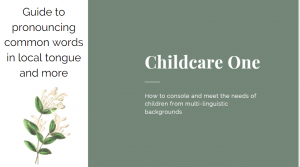33 Consoling and meeting children’s needs
Indiah Sinclair

View document: Consoling and meeting children’s needs
Rationale
A child’s first language is the way in which they make sense of their environment (Halliday, 2004). Children often come to early learning centres when English is not their first language or without the ability to speak or understand any English. Thus the need for a resource to aid educators to meet the needs of children from culturally and linguistically diverse backgrounds who have English as an additional language or dialect (EAL/D).
The above resource, How to console and meet the needs of children from multi-linguistic backgrounds, demonstrates to educators how to pronounce common words and needs of children in local Indigenous languages and common languages at the centre (e.g. Vietnamese). This resource uses local Indigenous websites and relevant Vietnamese translators. The resource has been created due to request of staff needing to meet the diverse needs of the children at their centre. Meeting the diverse needs of each child, according to the Early Years Learning Framework (DEEWR), 2009), ensure that children have a strong sense of identity; and feel safe, secure and supported. This resource assists educators to not only understand the child, but the educator can also communicate common phrases aided by a printable pictorial tool kit. Therefore, children’s needs are met i.e. children can point to things such as play, eat, drink or toilet. Meeting the holistic needs of all children is essential in any childcare organisation. This aligns with the Queensland Kindergarten Learning Guidelines (2018b) which highlights that educators must respect and include all children, and meet the needs of their social, cultural, linguistic backgrounds. By using this resource educators are able to engage children in a way they understand. According to Rojo (2010) children use their first language as a way to communicate, interact and develop meaningful relationships (Rojo, 2010). When educators are equipped to communicate in and support the first language, and interact with children from diverse cultural and linguistic backgrounds, the ability to build meaningful relationships occurs (Gallagher & Mayer, 2006).

